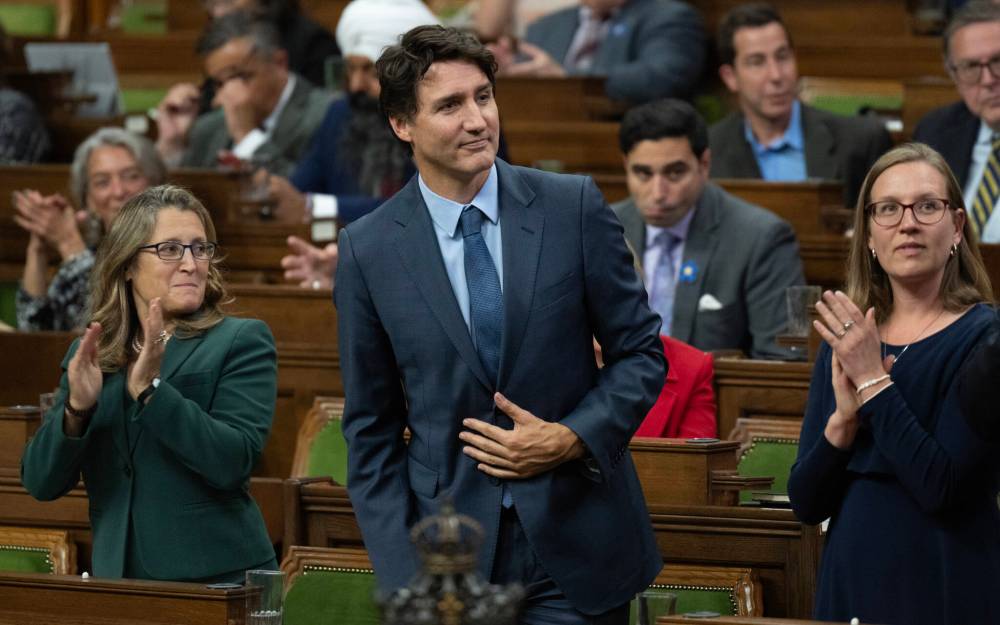So much for the federal government’s “fiscal guardrails.”
The Trudeau government promised Canadians a year ago that it would cap its deficit at $40 billion and reduce it over time. However, just like every year since it’s been in power, what the Liberals pledge on deficits and what they end up doing are two different things.
Canada’s parliamentary budget officer said last week the federal government likely failed to keep its deficit below $40 billion in 2023-24. Instead, the PBO estimated the shortfall will come in at about $46.8 billion.

It’s not a huge departure from the $40-billion promise. The problem is the deficit continues to grow and the Liberals keep moving the goal posts.
Despite a promise by Prime Minister Justin Trudeau in 2015, when the Liberals came into power, that he would run a series of small deficits — $10 billion or less — and reduce it to zero by 2019-20, the government has never balanced the books. Far from it.
The shortfalls grew beyond $10 billion (well before the COVID-19 pandemic hit) and have continued to soar since, more than doubling the national debt to more than $1.4 trillion. Much of that debt was unavoidably accumulated during the pandemic, but not all of it. And each new deficit grows it further.
There is still no sign the Liberals have a plan to tun that around. The PBO estimates the Trudeau government, at current spending levels, will post another deficit in 2024-25 of $46.4 billion.
In virtually every budget since 2015, the Trudeau government has promised to gradually lower the deficit and has reneged on that commitment every time.
In 2022, for example, there was a projected a deficit of $27.8 billion for 2024-2025 and a shortfall of $8.4 billion by 2026-2027. Two years later, in its 2024 budget, the estimated deficit for 2024-2025 grew to nearly $40 billion and the expected shortfall for 2026-2027 more than tripled to $30.8 billion.
Now the estimate for 2024-25 is $46.4 billion.
Finance Minister Chrystia Freeland argues that despite the growing deficits, the government is managing its finances “responsibly” because the debt-to-GDP — which is hovering at about 42 per cent (a historically high level) — is stable. But for how long? Prior to the pandemic it was around 31 per cent.
In the mid-1990s, when the federal government’s debt-to-GDP had grown to 67 per cent, then-Liberal finance minister Paul Martin vowed to balance the books “come hell or high water,” which he did. The manner in which he did it (slashing transfer payments to the provinces) was the wrong approach. But there was at least a sense of urgency in acknowledging that allowing the debt-to-GDP to grow further would have had disastrous financial implications for the country.
Debt-to-GDP is nowhere near where it was in the mid-1990s and interest rates today are lower, which means servicing the debt is less costly than it was under Martin. Still, without a plan to eventually balance the books, the risk that debt-to-GDP will continue to grow is very real, especially when government continually exceeds its deficit projections.
There’s also a matter of the debt itself. At $1.4 trillion and growing, that has to be repaid one day and it will be left to future generations to absorb.
As the federal debt grows, so too does the cost of servicing it. Interest on the debt has soared from $20.3 billion in 2020-2021 to $54.1 billion in 2024-2025. Some of that is driven by higher interest rates and some from a larger debt. But it’s money that is no longer available for program spending.
The bottom line is the Liberals can’t seem to control their spending. Even if some of it is worthwhile, such as a national dental plan or higher transfer payments to the provinces for health care, governments have to eventually live within their means. Failure to do so over time will have severe financial consequences, as was the case in the mid-1990s, when transfer payments to the provinces were slashed.
Saskatchewan nearly went bankrupt in the 1990s because it allowed its finances to deteriorate to the extent that it could barely borrow money anymore. That’s a warning signal all governments in Canada should heed.
It’s OK to run small deficits during recessions or during global emergencies such as a pandemic. But eventually spending has to align with revenues. That’s a concept the Trudeau government just can’t seem to wrap its head around.
tom.brodbeck@freepress.mb.ca

Tom Brodbeck
Columnist
Tom Brodbeck is a columnist with the Free Press and has over 30 years experience in print media. He joined the Free Press in 2019. Born and raised in Montreal, Tom graduated from the University of Manitoba in 1993 with a Bachelor of Arts degree in economics and commerce. Read more about Tom.
Tom provides commentary and analysis on political and related issues at the municipal, provincial and federal level. His columns are built on research and coverage of local events. The Free Press’s editing team reviews Tom’s columns before they are posted online or published in print – part of the Free Press’s tradition, since 1872, of producing reliable independent journalism. Read more about Free Press’s history and mandate, and learn how our newsroom operates.
Our newsroom depends on a growing audience of readers to power our journalism. If you are not a paid reader, please consider becoming a subscriber.
Our newsroom depends on its audience of readers to power our journalism. Thank you for your support.